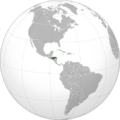The total primary energy offer in Honduras is around 4.62 Mtoe or 53,730.6 GWh[1].The main source of primary[1]energy is petroleum (53%) followed by combustible renewable and waste (44%), and coal (3%). The residential energy consumption[1]is around 47% of the national consumption, of which 86% are provided by biomass, primarily firewood.
Gross electricity generation of the national grid (Sistema Interconectado Nacional –SIN) is currently around 6,539 GWh, of which 53% are petrol power plants, 42% hydro power plants, 1% coal power plants, 1% gas and 3% co-generation.
The net electricity offer is around 6,494.1 GWh[2]including imports and exports. Consequently, 22.5% of the gross electricity production is lost. The losses are the highest in Central America after Nicaragua and 60% are classified as non-technical[3]. Following a recent study of the financial crisis of the state owned electricity company ENEE; 39% of the non technical losses are caused by fraud, 29% by illegal connections in marginalized settlements, 29% by errors in the billing, 2% by meter calibration and 2% by other causes; approximately[3]. While the illegal connection makes up 77% of the non technical losses caused by the residential sector (in total 39%), the fraud and billing errors occur especially in the commercial and industrial sector (50% of the non technical losses).
Besides this, as a result of a special investigation conducted by the Honduran Accounting Superior Court (Tribunal Superior de Cuentas) on ENEE’s direct contracting for the supply of electric energy to the system, have been disclosed to a broader audience a comparative analysis of the generation costs of thermal plants as well as the irregularities that ocurr on direct contracting processes. Among other aspects, this investigation concludes that the energy price offered was calculated considering the coal cost in one case 64% higher and other case 39% higher than international market prices.[4]
These losses as well as these higher energy prices limit the ENEE to invest in social electrification projects or expand infrastructure.
The installed capacity increased from 565 MW in 1994 to 1,605.79 MW (not firm) in 2009 while the demand increased from 453 MW to 1,203 MW in the same period[2]. According to the National Expansion Plan 2007-2020 expected demand growth is 5.7% annually[5]. For this reason, the contracting of 250 MW from renewable sources generated by private companies, which at the moment has been discussed by the National Congress; as well as the planned interconnection of the six power grids of the Central American countries (Central American Electrical Interconnection System), could contribute to meet demand growth for the future.
►Go to Top
Energy demand and Supply in Household Sector
[Show/hide]
As mentioned before, the main energy source for the residential sector comes from firewood, particularly in rural and peri-urban areas. The main use of this firewood is cooking, and in some cases lighting and heating.
It is estimated that a household, without access to electricity, uses approximately 525 kg of firewood per year.[6] Taking into consideration the total population without access to electricity in Honduras, that would means 11 million m3 per year.The calculated demand increased of firewood is 2.96% annually.[6]
The main source of firewood in Honduras is the forest. Due to this, the extraction of firewood is considerate one of the causes of deforestation at the national level[7] . Some studies indicate that between 1990 and 2005, Honduras lost 37.1% of its forest cover, or around 2,737,000 hectares . Despite this, 59% of its territory today remains covered by forests, but the estimated annual rate of deforestation of 62.000Ha/a.[8] boasts a fast reduction of this resource in Honduras.
The poverty of the population, the access to other energy sources, as well as the country’s rural population density, determines the usage of firewood as a main source of energy in Honduras. This could means that the usage of firewood, will not change in the short term, if the actual conditions of the energy sector in Honduras persist.
Under these circumstances, to make the use of firewood more efficient becomes a necessity thus to contribute to the reduction of the current actual rate of deforestation. One example is the use of improved firewood stoves. With these approximately 70% of the firewood is reduced in comparison to the traditional stoves. In addition to the reduction of the firewood consumption, there are other advantages for use of these stoves such as: more efficient use of heat, reduces the smoke in the kitchen which in turn reduces respiratory diseases by the inhalation of smoke, and improves hygiene in the home.[6]
Recently a study carried out in two rural communities in Honduras assessed the carbon monoxide and fine particulate matter levels among non-smoking Hondurans women cooking with traditional or improved wood-burning stoves. As a result’ of this study women with the improved stoves had 63% lower personal particle matter concentrations, 73% lower indoor particle matter concentrations, and 90% lower indoor carbon monoxide levels as compared to women with traditional stoves.[9]Which causes respiratory diseases.
Besides this, the study showed that it’s important to properly train the families as well as the local craftsmen(artisans) in stove maintenance and construction in order to decrease pollution emissions of these improved stoves in the future. This study concludes that designing kitchens with proper ventilation structures could lead to improved indoor environments, especially important in areas where biomass will continue to be the preferred and necessary cooking fuel for some time.[9]
►Go to Top
Costs of Electricity
Electricity is currently sold at an average price of 103 US$/MWh or 10.34 cents per KWh. The total cost including generation, transmission and distribution is calculated to be 127 US $/MWh or 12.75 cent per KWh. Due to the application of cross subsidies, specially applied to the residential sector, end users pay approximately 100 US $/MWh or 10 cents per KWh. In this sector it is estimated that only 80% of the feed is paid it by the end user[3] . Additionally adjustments to the cost per KWh have been postponed during 2009 and part of 2010, even though they are necessary due to increases in the oil prices.
Currently ENEE in its expansion plan has identified 41 projects to enlarge energy transmission and distribution, but only 27% are being funded. Mostly these funds comes by private and national funds and as well as loans[10].
►Go to Top
Rural Electrification
Honduras has one of the lowest rural electrification rates in Latin America after Nicaragua. About 54 percent of the rural population still lacks access to electricity[11]. In absolute terms, it is estimated that more than 386,000 households or more than 1.93 Million people in rural areas remain without access to electricity.
The national electricity system is concentrated in the western part of Honduras while the sparsely populated eastern part remains mainly beyond economic line-extension distances. The population density in Honduras is about 58 inhabitants per square kilometer. While in the western departments the density reaches proportions of 137 Inhabitants per km2 (Francisco Morazán) and 306 Inhabitants per km2 (Cortés), it declines to 17.5 in Olancho and 4 in Gracias a Dios - Mosquitia, both of them located in the eastern part of Honduras.
In rural areas population is highly dispersed and access to electricity is often difficult (for example, there is only river access to most of the Mosquitia Region). These two characteristics prevent provision of electric services by the conventional grid, and call for site-specific off-grid solutions such as diesel plants, solar or hydropower plants.
Off-grid electrification in Honduras consists mainly of installing diesel minigrids, operated by independent companies to serve some larger villages on the bay islands (Roatán Electric Company” RECO, “Utila Power Company” UPCO, “Bonaca Electric Company” BELCO) and in Puerto Lempira, Gracias a Dios (INELEM and ELESA). In a few cases hydroelectric and solar home systems have been implemented.
Otherwise in-grid electrification in the rural area is characterized by very old network working with secondary circuits which in some cases are too long and cause a large voltage drop and high losses[3]. For the time being efforts to increase the electricity coverage have been hindered due to an inexistent adequate rural electrification approach and policy which could contribute to articulate, the decentralization at a local level, the involvement of municipalities and the private sector, and the use of alternative energy local supplies.[3]
►Go to Top
Electricity Situation
[Show/hide]
Generation
ENEE (Empresa Nacional de Energia Electrica) owns 4 thermal power plants with a total capacity of 28.9 GWh[12]. Additionally, 7 hydropower plants with a total capacity of 2,539.6 GWh are owned an operated by ENEE[3]. The private sector has a total capacity of 3,992.4 GWh[3](14 thermal power plants with 3,578.8 GWh, 13 private hydropower plants with 257 GWh and 8 biomass cogeneration plants with 156,2 GWh[3].
►Go to Top
Transmission
ENEE is operating the national grid (SIN).
►Go to Top
Distribution
Monopoly by ENEE with the exception of some isolated grids on the bay islands (Roatán Electric Company” RECO, “Utila Power Company” UPCO, “Bonaca Electric Company” BELCO) and in Puerto Lempira, department of Gracias a Dios (INELEM and ELESA).
►Go to Top
Key Problems Hampering Access to Modern Energy Services in Rural Areas
[Show/hide]
Obstacles for Grid-based Rural Electrification
Several factors handicap rural electrification in Honduras:
- Insufficient financial resources for investments in grid extension and installation of minigrids: ENEE as the host of the OES-FOSODE promotes rural electrification mainly by grid extension, but the considerable funds made available by international donors are still not sufficient to reach the targeted increase from 69% in 2006 to 80% by 2015.
- Low fees and financial problems of ENEE: (a) cross subsidies to help the poorest customers were badly targeted and unsustainable causing a constant income loss for ENEE. Currently the average subsidy for small residential consumers is about US$ 1.90 per month for which ENEE is compensated by the state. (b) Particularly commercial, industrial and public customers often don’t pay their bills due to fraud or billing problems (60% of the non technical losses). (c) As 63% of the electricity generation is based on petrol, costs increase with the international petrol price. At the same time ENEE has to fulfill expensive power purchase agreements concluded during former energy crisis. ENEE is unable to compensate increased costs with the current fees. As a consequence, investments in the generation, transmission and distribution of infrastructure are low.
- Beside the current distribution monopoly of ENEE, private companies invest only in exceptional cases in mini grids, as in the case of the bay islands where considerable resources and economic interest exists due to the strong tourism infrastructure. Normally, costs of providing access are too high due to remoteness of the sites, dispersed populations and difficulty of the terrain. Local communities don’t dispose of sufficient proper financial resources to make infrastructure investments in their community.
- The subsidies fees promote an excessive use of electricity in households. With about 200 kWh/month, the consumption is almost twice as high as in El Salvador or Guatemala. The low price makes cooking and water heating with electricity cheaper than with LPG.
►Go to Top
Obstacles for Off-grid Energy Technologies and Services
- There is a strong political motivation to improve access to electricity of rural populations, particularly those far from the grid. However, the cost of doing so has become increasingly high and there has been little effort to adopt new technologies and approaches. Grid extension is virtually the only approach by ENEE / OES-FOSODE to rural electrification and little attention has been paid to decentralized options.
- Other actors like SERNA or NGOs act uncoordinated from OES-FOSODE and lack sufficient financial resources to carry out dissemination programs for off-grid technologies.
- Lack of skills in operating small power generating plants and mini grids. There are few examples where micro and mini hydro power plants are managed successfully in rural areas in Honduras and the number of sufficiently qualified persons is low. This refers to technical skills necessary to maintain and repair the system as well as to management skills regarding appropriate fee-setting and operation of the plant.
- Insufficient availability of micro-finance schemes for energy technologies in rural areas. Large parts of the country have almost no access to institutional micro-finance services and must rely largely on moneylenders, suppliers, family and friends for short term seasonal loans. There are no secure liquid savings options available to these households, which would enable them to build assets over time. Existing micro-finance institutions often have a narrow credit product line (e.g. Soluz offers credit sales but only with down payment off 50% and a payback time of up to 6 months), limited experience in rural markets and a lack of access to best practice information and technical tools.
- Lack of a marketing and maintenance structure for energy technology devices in rural areas. Almost all retailers are established in cities with no outlets are in the rural communities. Thus, clients have to travel to cities to purchase energy devices and for repair orders, which is difficult for most rural families. Establishing rural outlets are considered not to be profitable due to the high costs for transportation and mobilization, the dispersed nature of the populations and the low income and low demand of the local population.
►Go to Top
Institutional Set Up and Actors in the Energy Sector
[Show/hide]
Honduras power sector started a deep restructuring in 1994, as a consequence of a crisis. As a result, a new Electricity Law was elaborated which opened the possibility to generate, transmit and distribute energy, which was being managed exclusively by the state-owned Empresa Nacional de Energia Electrica (ENEE). Another important step was to separate the roles of policy makers, the regulators and providers of electrical services.
However, only the generation was opened to private producers while ENEE stills buys all electricity via long term power purchase contracts and manages the national transmission system (SIN) and the distribution. ENEE faces a deep financial crisis since the year 2000 and later in 2005 the discussion about finally unbundling ENEE has been taking place. Talks of increasing the generation capacity and the elaboration of a power sector strategy for the country has intensified.
►Go to Top
Public Institutions
Some public institutions involved in the energy sector are: The Energy Cabinet, The Ministry for Nature Resources and Environment (Secretaría de Recursos Naturales y Ambiente - SERNA), The National Energy Commission (CNE), the national electricity utility (Empresa Nacional de Energía Electrica-ENEE), and others.
Energy policy in Honduras remains highly disorganised with many different institutions involved without a clear separation of responsibilities and tasks. The main conflict lies in the fact that the Ministry for Natural Resources and Environment (Secretaría de Recursos Naturales y Ambiente - SERNA) through its subsection Dirección General de Energía (DGE) has the formal responsibility while the national electricity utility Empresa Nacional de Energía Electrica (ENEE) whose director takes up even the rank as minister, has the technical expertise and support, and maintains the control of all the activities connected to the SIN.
Even the Fondo Social de Desarrollo Eléctrico (FOSODE) which was founded in 1994 with the aim to increase the electrification rate is managed by the Oficina de Electrificación Social (OES) as a subsection of the ENEE. Consequently all grid connected activities are implemented by the ENEE while SERNA in cooperation with some international donors implementing off grid projects based on solar and hydroenergy.
At the same time even the Ministries of Health and Agriculture, the Council on Science and Technology (Consejo Hondureño de Ciencia y Tecnología – COHCIT) (with the rank of a ministry as well) and the Honduran Social Investment Fund (Fondo Hondureno de Inversion Social-FHIS) have implemented some off grid renewable energy projects specially in rural areas parallel and/or without coordination.
►Go to Top
Non Governmental Service Providers for Rural Areas
Projects Implementing NGOs
Energy is only a side topic for most Honduran NGOs. The umbrella of development organisations, the Federación de Organizaciones Privadas de Desarollo – FOPRIDEH with 73 members, is not focusing on rural energy supply.
There are two Honduran NGOs, AHDESA and PROLEÑA which have expertise with to the introduction of improved stoves. They are both partners of the EnDEv-HO Project. The project involves several NGOs in the dissemination of stoves and SHS of which the most important is Hermandad de Honduras.
As to rural electrification, almost no information exists about Honduran NGOs that implement their own projects. This reflects the strong monopoly of ENEE, which still is regarded by most Hondurans as the entity responsible for rural electrification.
However, some very small scale activities have been carried out by the Fundación Hondureña de Investigación Agrícola (FHIA) in the field of micro hydro power, who, by the way is also a partner of EnDev Ho.
►Go to Top
Commercial Service Provider
In the field of photo voltaic systems about 8 providers work in Honduras of which Solaris, Soluz, CADELGA and Soluciones Energeticas are the most important. The Solar companies in general have difficulties developing markets in rural areas. The different subsidy schemes of international donors make the commercial distribution even more difficult.
Soluz has developed interesting activities in the field of cash and credit sale as well as in offering fee for service options. About 6000 SHS have been sold to rural customers. The credit offer requires a 50% down payment and 3 to 6 monthly payments with an interest rate of 3 % per month.
The fee for service approach with 1500 SHS had to be terminated after the end of the World Bank´s credit support, as the service fees have not been sufficient to cover the primary investment costs of the systems. SOLUZ has calculated that a monthly fee of 18 $ would be required while the customer has to pay the battery himself.
There are just a few producers of agriculture machines that produce hydropower turbines and the technical level is very low. The customers are mostly owners of coffee plantations, therefore FHIA started to produce hydropower turbines itself.
►Go to Top
Other Organizations Involved in this Sector
Associations: The hydro power, solar, geothermic, wind and biomass private operators are organized in the Asociación Hondureña de Pequeños Productores de Energía Renovable – AHPPER. Through this organization small project developers can receive technical assistance to elaborate feasibility studies and business plans, as well as to locate credit opportunities, equipment and specialized technical assistance.
Regional and International organizations
The Centro American Bank of Economic Integration (Banco Centroamericano de Integracion Economica -BCIE) with the implementation of the ARECA Project promotes funding for renewable energy projects through the reduction of financial barriers, by implementing a mechanism for partial credit guarantee and capacity building to foster the development of small projects the involved renewable energy in Central America (under 10 MW). The funds for this project come from the Global Environment Fund and are supervised by UNPD in Honduras.
The European Commission through the project “energy efficiency and renewable energy for SME´s”, enabled the access to funds for investments that reduce energy consumption, that increase energy efficiency and different types of renewable energy technology for power generation.
World Bank is currently working on a project whose goal is to generate between 59 and 100 kW using Micro Hydro power in various rural areas in Honduras.
►Go to Top
Policy Framework
[Show/hide]
Energy Policy
For the electric sector, all policy is based on the Electricity Law of 1994, which defines roles and responsibilities of the institutions described above. This Law regulates the generation, transmission, distribution and commercialization of electricity; as well as promoting private invest, especially for power production and distribution. It also establishes a fee regime and exonerates all taxes on energy sale.
During 1998 the “Incentives law from renewable sources” was approved by the National Congress. Later on 2007 the national congress passed the new law on renewable energy which replaces the law from 1998. The law promotes the use of renewable energies for the electricity generation by custom tax exoneration. The valued added tax (12%) is not part of the exoneration. In addition the law foresees income tax exoneration for the power producer. Additionally ENEE is forced to buy power generated from renewable energy plants at an increased fee. Since this exoneration does not address off grid power plants, the incentives favor the larger grid connected power plants. Thus, the new law has only minor impact on small renewable energy projects.
In 2005 SERNA approved a sustainable energy action plan which is currently updated for the period up to 2030 (Plan de Acción para la Implementación de una Política Energética Nacional Sostenible). The plan covers the whole range of renewable energy, energy efficiency and rural electrification and defines several milestones including the goal to reduce the national firewood consumption by 10 %. However, SERNA does not implement any off-grid projects. Its mandate is to define the general energy policy of the government. The dissemination of improved stoves is spearheaded by the two NGOs PROLEÑA y AHDESA.
The biofuel production and consumption law (Decree 144-2007) promotes the production of bio-fuel through tax exoneration. This exoneration is valid for a period of 12 years and benefits private companies located in Honduras, which use national raw material to produce energy. The law designates the Secretary of Industry and Commerce as the institution responsible of elaborating policies for bio-fuel production, operations authorizations, and certification of each industrial and commercial activity related to the bio-fuel productive chain.
During 2010 the National Congress approved a national plan in effect for seven presidential terms,“Vision of Country 2010-2038 and Nation Plan 2010-2022”. One of the goals of this plans is to have 80% of the energy matrix which comes from renewable energies sources, through private and public investment -with emphasis on hydroelectric power-, and sales of reduction emission certificates (CERs). The plan also aims to reduce rural population without access to electricity to 55% by 2022 and to 0% by 2034. This plan is the first plan in Honduras for which a specific law has been created. The first projects are expected to be implemented in 2011.
►Go to Top
Energy Policies for Rural Electrification
As described above the policy regarding rural electrification is mainly developed and executed by ENEE via the OES-FOSODE. FOSODE was able to raise significant funds from international donors in the last decade, resulting in an annual budget of around $10 million per year[5] . From 2001 up to 2008 137,337 households have gained electricity trough FOSODE[13]. At this rate, ENEE could increase the electrification rate from 43% in 1994 to 79.3% in 2009 [12].
Due to the high demand for electricity from rural communities, since 2002 ENEE with support of CIDA has developed a “Plan Nacional de Electrificación Social” (PLANES) whose aim is to increase the coverage of the national grid to rural areas and peri-urban marginalized settlements. The scope of PLANES, which was initially planned to terminate in 2012, has been extended to 2015 with an increase in the electrification rate, which is now of 80%. Currently, the activities are mainly concentrated on grid extension, only about 25 diesel powered mini-grids has been included. However, there are doubts that this approach is economically feasible.
The average costs for grid connection of rural households quickly increases if the remoter villages are targeted. Consequently, during the last grid extension projects of ENEE the costs exceeded US$ 700 per household . Other studies claim costs in excess of US$ 1000 per household including required investments in transmission grids of ENEE. To reach the goal of an electrification rate of 80% by 2015, average annual investments of US$ 40 million from 2005 to 2015 have been estimated instead of the US$ 10 million p.a. which FOSODE has worked with up to 2008.
Additionally, the current subsidies on electricity increase with every new connection, which adds on the costs of grid extension. Therefore, the World Bank is currently propose to make FOSODE an independent institution promoting rural electrification and to focus more on off grid options using renewable energy[3].
►Go to Top
Other Policies and Regulations
The Forest, Protected Areas and Wildlife Law (Decree 98- 2007), is considered the framework for all activities related to the forest sector. Some aspects related to the energy sector that the law mentions are:
- Establishment of forest plantation with energy purposes (Dendro energy), considered in the law as a national priority as well as the efficiency of firewood use in the household and the industry sector. For this kind of plantation the law sets incentives which will be define for the public institution responsible for the implementation of this law “National Institute of Forest Conservation and Development” (ICF). This law also establishes that starting 2012 the use of wood and coal in the industry and commercial sector must come from certified plantations, managed forests, waste from forest industry or forestry activities.
- Special regimes for watersheds management are also contemplated. This applies to all watersheds, sub and micro-watersheds which supply water for domestic and productive use, energy production and others. Activities such as the delimitation and protection of these watersheds are mandatory.
The National water use law (Decree 83-1945) determines the priority use of national water as well as it indicates for which uses one could make a concession of national water.
The General Environmental Law (Decree 104-1993), establish that all activities concerning to electricity generation and transmission must be reported to the Environmental Authorities, and could not be carry out these activities without a environmental evaluation and authorization. In particular hydro electrical projects, depending on its size, have to get either an environmental registration (0.5-1MW), an environmental authorization (1-3 MW) or an environmental license (>3MW)
►Go to Top
Opportunities for Rural Electrification
[Show/hide]
The World Bank analyzed the cost and advantages of different options for rural electrification as shown below, with the following conclusions:
- Grid extension is not always the most cost efficient option. Particularly in geographic areas where access is difficult.
- Hydro power is expensive than other alternatives. These should be implemented if local hydro potentials have been confirmed, feasibility studies can confirm hydro power to be the least costly option for the local communities and other uses of energy, besides the residential use, are include in the project. (Productive uses).
- SHS are comparatively cheap but energy service is limited and business and service systems are critical and often have high transaction costs.
The World Bank concludes that the least expensive solution to reach the goal of the Honduras Government of 400,000 new connections by 2015 would be the dissemination of SHS.
With 50% of 20Wp SHS for US$ 400 each and 50% of 50 Wp SHS for US$ 600 each, the total cost of the disseminated systems would be of US$ 200 millions and would require an annual budget of approx. US$ 22 millions per year [3].
►Go to Top
Further Information
[Show/hide]
References
[Show/hide]
- ↑ Jump up to: 1.0 1.1 1.2 IEA. 2010. Energy balances of non-OECD countries. OECD-IEA. Paris, France. 453 p. Cite error: Invalid
<ref> tag; name "IEA" defined multiple times with different content Cite error: Invalid <ref> tag; name "IEA" defined multiple times with different content
- ↑ Jump up to: 2.0 2.1 CEPAL.2010.Itsmo Centroamericano:estadisticas del subsector electrico (datos preliminares).Mexico DF,Mexico. 28 p. Cite error: Invalid
<ref> tag; name "CEPAL" defined multiple times with different content
- ↑ Jump up to: 3.0 3.1 3.2 3.3 3.4 3.5 3.6 3.7 3.8 3.9 _ Cite error: Invalid
<ref> tag; name "ESMAP" defined multiple times with different content Cite error: Invalid <ref> tag; name "ESMAP" defined multiple times with different content Cite error: Invalid <ref> tag; name "ESMAP" defined multiple times with different content Cite error: Invalid <ref> tag; name "ESMAP" defined multiple times with different content Cite error: Invalid <ref> tag; name "ESMAP" defined multiple times with different content Cite error: Invalid <ref> tag; name "ESMAP" defined multiple times with different content Cite error: Invalid <ref> tag; name "ESMAP" defined multiple times with different content Cite error: Invalid <ref> tag; name "ESMAP" defined multiple times with different content Cite error: Invalid <ref> tag; name "ESMAP" defined multiple times with different content
- ↑ TSC.2009.Investigacion especial sobre los resultados y seguimento de la contratacion directa de suministro de energía:Informe de investigación especial No. 07/2009-DA. Tribunal Superior de Cuentas, Gobierno de la Republica de Honduras. Tegucigalpa, Honduras. 27 p.
- ↑ Jump up to: 5.0 5.1 PNUD.2008. Prospectiva Energetica y Escenarios Posibles. PNUD. Tegucigalpa, Honduras. 115 p Cite error: Invalid
<ref> tag; name "PNUD" defined multiple times with different content
- ↑ Jump up to: 6.0 6.1 6.2 FHIA. 2009. Noticias de la FHIA:mejorando el ambiente de la familia rural y conservando los recursos naturales. Boletín 26. La Lima, Cortes. 5 p. Cite error: Invalid
<ref> tag; name "FHIA" defined multiple times with different content Cite error: Invalid <ref> tag; name "FHIA" defined multiple times with different content
- ↑ Gobierno de la República de Honduras. 2001. Estrategia nacional de reducción de la pobreza.
- ↑ Suazo, T. 2010. Gestión Forestal y el Desarrollo Sostenible de Honduras. Presentación en el marco del "taller nacional bosques y cambio climatico: oportunidades del país para insertarse en el mecanismo REDD". Tegucigalpa, Honduras. 17 p.
- ↑ Jump up to: 9.0 9.1 Clark, Maggie; et.al. 2010. Indoor air pollution, cook-stove quality, and housing characteristics in two Honduras communities. Environmental Research Journal. Vol 110:1. Elsevier. Page 12-18. Cite error: Invalid
<ref> tag; name "Clark, Maggie" defined multiple times with different content
- ↑ ENEE. 2009. Empresa Nacional de Energía Electrica: situación actual y perspectivas.ENEE. Tegucigalpa, Honduras.58 p.
- ↑ INE.2009.Boletín de prensa:En Honduras el acceso a servicio de energía eléctrica se concentra en área urbana. INE. Tegucigalpa, Honduras.2 p.
- ↑ Jump up to: 12.0 12.1 ENEE.2010. Estadísticas 2009: Energía disponible en el Sistema Interconectado Nacional-periodo 2008-2009. Sud-Dirección de Planificación, ENEE. Tegucigalpa, Honduras. 1 p Cite error: Invalid
<ref> tag; name "ENEE" defined multiple times with different content
- ↑ ENEE.2008. Informe de Proyectos de electrificacion realizados en el periodo 2002-2008. Division de Ingenieria. ENEE. Tegucigalpa, Honduras. 1 p.
►Go to Top






















